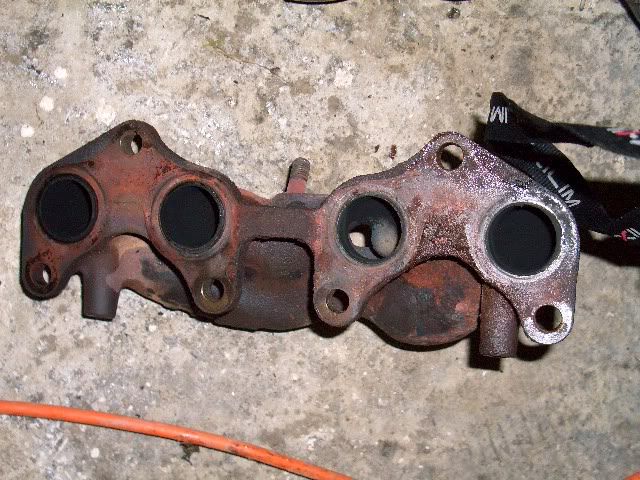You are using an out of date browser. It may not display this or other websites correctly.
You should upgrade or use an alternative browser.
You should upgrade or use an alternative browser.
How does standard manifold kill engines?
- Thread starter Corleone
- Start date
AntEP82
Member +
It only kills the engine if you run high boost e.g. 1 bar. I assume it's because the manifold cannot flow all of the air out of the engine quick enough and so air get's forced back into the cylinder and messes the timing up? Sure many people know exactly but i don't have much mechanical knowledge
billybob
Untrusted Seller
its ok for the standerd gt when upgrading you get restriction is very bad on the engine thats why uprated ones are made keeping engine cool and not as hot,bad points keeping standerd is cracking bits going in to turbo and messing the turbo up.in terms it adds to roasting your engine when upgrading
Dave.
Member +
I was always under the impression that the restriction in the manifold, under higher boost pressures impeded the flow of exhaust gas from the cylinder, leading to higher cylinder temperatures... Which in turn damages the piston/rings.
I've never really thought in detail about why this would cause the cylinder behind the restriction to be heated more than the others, perhaps because the gas is there for longer, or in someway related to the expansion of the gas being more intense, as it is not allowed to exit the cylinder on the down-stroke of the piston as readily as the other cylinders? (Which would generate more heat in itself due to the volume remaining the same, but a higher pressure being present!)
All I can think of, will be interesting to see how it holds up lol
Dave
I've never really thought in detail about why this would cause the cylinder behind the restriction to be heated more than the others, perhaps because the gas is there for longer, or in someway related to the expansion of the gas being more intense, as it is not allowed to exit the cylinder on the down-stroke of the piston as readily as the other cylinders? (Which would generate more heat in itself due to the volume remaining the same, but a higher pressure being present!)
All I can think of, will be interesting to see how it holds up lol
Dave
Last edited:
Monkfish
Member +
The gasses don't exit the cylinder on the downstroke, both valves are shut on the 2nd (compression) stroke and remain shut during the 3rd (Expansion) stroke and until the piston approaches Bottom Dead Centre (BDC). At this point the exhaust valve opens and the exhaust gasses are pushed out as the piston comes back up for the 4th (exhaust) stroke. Then, at Top Dead Centre (TDC) the exhaust valve closes, the inlet valve opens and the piston travels back down and draws in fuel/air mixture as part of the 1st (intake) stroke.I was always under the impression that the restriction in the manifold, under higher boost pressures impeded the flow of exhaust gas from the cylinder, leading to higher cylinder temperatures... Which in turn damages the piston/rings.
I've never really thought in detail about why this would cause the cylinder behind the restriction to be heated more than the others, perhaps because the gas is there for longer, or in someway related to the expansion of the gas being more intense, as it is not allowed to exit the cylinder on the down-stroke of the piston as readily as the other cylinders? (Which would generate more heat in itself due to the volume remaining the same, but a higher pressure being present!)
Anyway, the restriction would impede the gasses being fully evacuated from the cylinder. Theoretically, that would mean that on the intake stroke there would still be some exhaust (waste) gas in the cylinder (There is always some, but it's a little more than usual) mixing in with the fuel/air being drawn into the engine. This would probably cause that cylinder to run marginally leaner than the rest and burn slightly hotter. Over time and after prolonged abuse, this extra heat takes its toll on the pistons, rings and valves.
In short, a stock manifold is bad. A ported stock manifold should be ok, but most tend to just bin it and get a stainless one, although having had 3 that have all cracked, I'd not bother. The problem with them seems to be that, to keep costs down, the flanges are made from mild steel and the runners are stainless. Mild steel and stainless expands at different rates which would cause tension in the manifold and stress the welds. Over time and with constant warming/cooling cycles, they fatigue and crack.
If I buy a new manifold for The Bitch, it'll probably be one of Dane's all mild steel items.
ChrisGT
Member +
The gasses don't exit the cylinder on the downstroke, both valves are shut on the 2nd (compression) stroke and remain shut during the 3rd (Expansion) stroke and until the piston approaches Bottom Dead Centre (BDC). At this point the exhaust valve opens and the exhaust gasses are pushed out as the piston comes back up for the 4th (exhaust) stroke. Then, at Top Dead Centre (TDC) the exhaust valve closes, the inlet valve opens and the piston travels back down and draws in fuel/air mixture as part of the 1st (intake) stroke.
Anyway, the restriction would impede the gasses being fully evacuated from the cylinder. Theoretically, that would mean that on the intake stroke there would still be some exhaust (waste) gas in the cylinder (There is always some, but it's a little more than usual) mixing in with the fuel/air being drawn into the engine. This would probably cause that cylinder to run marginally leaner than the rest and burn slightly hotter. Over time and after prolonged abuse, this extra heat takes its toll on the pistons, rings and valves.
In short, a stock manifold is bad. A ported stock manifold should be ok, but most tend to just bin it and get a stainless one, although having had 3 that have all cracked, I'd not bother. The problem with them seems to be that, to keep costs down, the flanges are made from mild steel and the runners are stainless. Mild steel and stainless expands at different rates which would cause tension in the manifold and stress the welds. Over time and with constant warming/cooling cycles, they fatigue and crack.
If I buy a new manifold for The Bitch, it'll probably be one of Dane's all mild steel items.

Very informative post! Repped. And I fully agree; I have had 2 stainless manifolds and both cracked! I am now using one of Danes mild steel ones and it is going strong!
Corleone
Member +
I had always thought of just terrible thing like pistons melting etc.
But I guess it would have some sort of EGR effect from gasses not being able to escape and cause you to run quite lean? Possibly?
I only ask because im designing an exhuast manifold and was wondering why exactly that restriction in the third runner causes engine failure.
But I guess it would have some sort of EGR effect from gasses not being able to escape and cause you to run quite lean? Possibly?
I only ask because im designing an exhuast manifold and was wondering why exactly that restriction in the third runner causes engine failure.
Monkfish
Member +
It's for one of the studs that secures the turbo to the manifold. If you look at the picture Enzo posted you can see the restriction and the white marks on it. The white indicates it getting very hot, whereas the rest of the manifold is just coated in carbon deposits.Why is there a restriction in runner 3?
Monkfish
Member +
You might find that with the restriction removed, the stock manifold performs just as well as any aftermarket one.Because its shit.
My valuble input.
Yeh, that's fine. It only comes and issue when you crank the boost up to 1 Bar.Interesting thread.
Is it ok to run a standard mani on a mildly tuned ep91?
No extensive mods - decat, filter, exhaust, boost restriction bypassed.
stuart
Member +
You might find that with the restriction removed, the stock manifold performs just as well as any aftermarket one.
I ran a ported one for quite awhile.
Self-port ftw!
Monkfish
Member +
Did you have any issue with it leaking/cracking or securing the turbo to it? I think I have my stock one kicking around and I might put it back on as my stainless one is rapidly fucking itself.I ran a ported one for quite awhile.
Self-port ftw!
Also, I've just updated this post with a link back to this topic as it contains some useful information.

